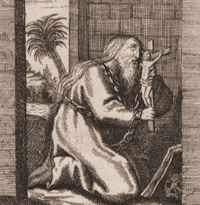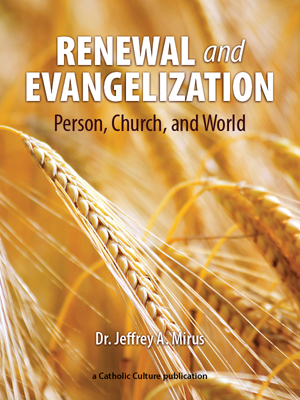Lent: February 28th
Saturday after Ash Wednesday
Other Commemorations: St. Hilary, Pope (RM); St. Romanus of Condat, Abbot (RM); Bl. Daniel Brottier (RM)
» Enjoy our Liturgical Seasons series of e-books!
Then he questioned his father, "How long has this been happening to him"? He replied, "Since childhood. It has often thrown him into fire and into water to kill him. But if you can do anything, have compassion on us and help us." Jesus said to him, " 'If you can!' Everything is possible to one who has faith." Then the boy's father cried out, "I do believe, help my unbelief!" Jesus, on seeing a crowd rapidly gathering, rebuked the unclean spirit and said to it, "Mute and deaf spirit, I command you: come out of him and never enter him again" (Mark 9:21-26)
Thanks to Fear of the Lord, There is no Fear of Evil
History, in fact, is not alone in the hands of dark powers, chance or human choices. Over the unleashing of evil energies, the vehement irruption of Satan, and the emergence of so many scourges and evils, the Lord rises, supreme arbiter of historical events. He leads history wisely towards the dawn of the new heavens and the new earth, sung in the final part of the book under the image of the new Jerusalem (cf. Revelation 21-22).
It must be reaffirmed, therefore, that God is not indifferent to human events, but penetrates them realizing his "ways," namely his plans and his efficacious "deeds."
According to our hymn, this divine intervention has a very specific purpose: to be a sign that invites all the peoples of the earth to conversion. Nations must learn to "read" in history a message of God. Humanity's history is not confused and without meaning, nor is it given over, without appeal, to the malfeasance of the arrogant and perverse. There is the possibility to recognize divine action hidden in it. In the pastoral constitution "Gaudium et Spes," Vatican Council II also invites the believer to scrutinize, in the light of the Gospel, the signs of the times to see in them the manifestation of the very action of God (cf. n. 4 and 11). This attitude of faith leads man to recognize the power of God operating in history, and thus to open himself to fear of the name of the Lord. In biblical language, in fact, this "fear" does not coincide with dread, but is the recognition of the mystery of the divine transcendence. Because of this, it is the basis of faith and is joined with love: "the Lord your God requires of you, but to fear the Lord your God, to walk in all his ways, to love him, to serve the Lord your God with all your heart and with all your soul" (cf. Deuteronomy 10:12).
Following this line, in our brief hymn, taken from Revelation, fear and glorification of God are united: "Who will not fear you, Lord, or glorify your name" (15:4)? Thanks to fear of the Lord there is no fear of the evil that rages in history and one takes up again with vigor the journey of life, as the prophet Isaiah declared: "Strengthen the hands that are feeble, make firm the knees that are weak, say to those whose hearts are frightened: Be strong, fear not!'" (Isaiah 35: 3-4).
Excerpted from Thanks to Fear of the Lord, There Is No Fear of Evil, Pope Benedict XVI, May 11, 2005
Things to Do:
- Your children may want to spend their Saturday afternoon learning about different local charitable organizations or needy families to whom the alms from the family's Lenten Jar will be given.
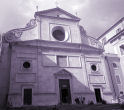
The station for today is at the church dedicated to St. Augustine of Hippo. Michalangelo was one of the artists commissioned for the decoration of the church. The Renaissance façade, one of the first in this style, is built of travertine marble said to be from the ruins of the Colosseum.
St. Hilary
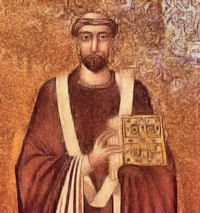 To replace a man like Leo was not easy, but the next pope was a man after Leo's heart, the archdeacon Hilary. Hilary was a Sardinian who had joined the Roman clergy and had been sent by St. Leo as one of the papal legates to the council at Ephesus in 449. This council, intended to settle the Monophysite affair, got out of hand. Packed with Monophysites and presided over by Dioscorus, the patriarch of Alexandria, the assembly refused to listen to the protests of the papal legates. Dioscorus steam-rollered through the council a condemnation of the orthodox and saintly Flavian, patriarch of Constantinople, and an approval of the Monophysite leader Eutyches. In vain Hilary protested. He had to fly in fear for his life and hide in a chapel of St. John the Evangelist. It was only with difficulty that he got back to Rome. No wonder St. Leo called this Ephesus council a gathering of robbers!
To replace a man like Leo was not easy, but the next pope was a man after Leo's heart, the archdeacon Hilary. Hilary was a Sardinian who had joined the Roman clergy and had been sent by St. Leo as one of the papal legates to the council at Ephesus in 449. This council, intended to settle the Monophysite affair, got out of hand. Packed with Monophysites and presided over by Dioscorus, the patriarch of Alexandria, the assembly refused to listen to the protests of the papal legates. Dioscorus steam-rollered through the council a condemnation of the orthodox and saintly Flavian, patriarch of Constantinople, and an approval of the Monophysite leader Eutyches. In vain Hilary protested. He had to fly in fear for his life and hide in a chapel of St. John the Evangelist. It was only with difficulty that he got back to Rome. No wonder St. Leo called this Ephesus council a gathering of robbers!
As pope, Hilary worked hard to foster order in the Gallic hierarchy. When a certain Hermes illegally made himself archbishop of Narbonne, two Gallic delegates came to Rome to appeal to Pope Hilary. He held a council at Rome in 462 to settle the matter. He also upheld the rights of the see of Arles to be the primatial see of Gaul. From Spain also came appeals of a similar nature. To settle these Hilary held a council at Rome in 465. This is the first Council at Rome whose acts have come down to us. According to the "Liber Pontificalis" he sent a letter to the East confirming the ecumenical councils of Nicaea, Ephesus, and Chalcedon, and the famous dogmatic letter of his predecessor St. Leo to Flavian. He also publicly in St. Peter's rebuked the shadow-emperor Anthemius for allowing a favorite of his to foster heresy in Rome.
St. Hilary deserves great credit for his work in building and decorating churches in Rome. Of especial interest is the oratory he built near the Lateran, dedicated to St. John the Evangelist. The Pope attributed his escape from the wild Monophysites at Ephesus to the intercession of the Beloved Disciple, and to show his gratitude he built this beautiful oratory. Over its doors may still be seen the inscription, "To his deliverer, Blessed John the Evangelist, Bishop Hilary, the Servant of Christ." Hilary built two more churches and spent freely in decorating still others. The gold and silver and marble used so lavishly by this Pope in adorning the Roman churches indicate that the wealthy families of Rome must have saved something from the grasping hands of Goths and Vandals.
St. Hilary died on February 29. His feast is celebrated on February 28.
—Excerpted from Defending the Faith
Highlights and Things to Do:
- Read more about St. Hilary or Hilarus:
- St. Hilary's relics are buried in Basilica Papale di San Lorenzo fuori le mura (Papal Basilica of St. Laurence Outside the Walls.
Saint Romanus of Condat
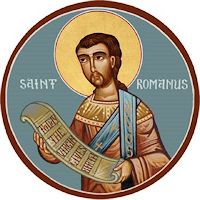 Romanus at thirty-five years of age left his relatives and spent some time in the monastery of Ainay at Lyons, at the great church at the conflux of the Saône and Rhone which the faithful had built over the ashes of the famous martyrs of that city; for their bodies being burned by the pagans, their ashes were thrown into the Rhone, but a great part of them was gathered by the Christians and deposited in this place.
Romanus at thirty-five years of age left his relatives and spent some time in the monastery of Ainay at Lyons, at the great church at the conflux of the Saône and Rhone which the faithful had built over the ashes of the famous martyrs of that city; for their bodies being burned by the pagans, their ashes were thrown into the Rhone, but a great part of them was gathered by the Christians and deposited in this place.
Romanus a short time after retired into the forests of Mount Jura, between France and Switzerland, and fixed his abode at a place called Condate, at the conflux of the rivers Bienne and Aliere, where he found a spot of ground fit for culture, and some trees which furnished him with a kind of wild fruit. Here he spent his time praying, reading, and laboring for his subsistence.
Lupicinus, his brother, came to him sometime after in company with others, who were followed by several more, drawn by the fame of the virtue and miracles of these two Saints. Their numbers increasing, they built several monasteries, and a nunnery called La Beaume, which no men were allowed ever to enter, and where St. Romanus chose his burial-place.
The brothers governed the monks jointly and in great harmony, though Lupicinus was the more inclined to severity of the two. Lupicinus used no other bed than a chair or a hard board; never touched wine, and would scarcely ever suffer a drop either of oil or milk to be poured on his pottage. In summer his subsistence for many years was only hard bread moistened in cold water so that he could eat it with a spoon. His tunic was made of various skins of beasts sewn together,. with a cowl; he used wooden shoes, and wore no stockings unless when he was obliged to go out of the monastery.
St. Romanus died about the year 460, and St. Lupicinus survived him almost twenty years.
Patronage: against insanity; against mental illness; drowning victims; mentally ill people
Highlights and Things to Do:
- Read more about St. Romanus of Condat:
- St. Romanus' relics are now in Abbey of Saint-Romain-de-Roche.
Bl. Daniel Brottier
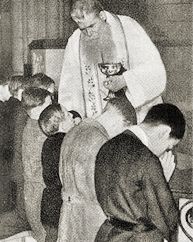 Blessed Daniel Brottier was a French Spiritan born in France in 1876 and ordained priest 1899. His zeal for spreading the Gospel beyond the classroom or the confines of France made him to join the Spiritan Congregation.
Blessed Daniel Brottier was a French Spiritan born in France in 1876 and ordained priest 1899. His zeal for spreading the Gospel beyond the classroom or the confines of France made him to join the Spiritan Congregation.
He was sent to Senegal, West Africa. After eight years there, his health suffered and he went back to France where he helped raise funds for the construction of a new cathedral in Senegal.
At the outbreak of World War I Daniel became a volunteer chaplain. He attributed his survival on the front lines to the intercession of Saint Therese of Lisieux, and built a chapel for her at Auteuil when she was canonized.
After the War he established a project for orphans and abandoned children "the Orphan Apprentices of Auteuil" in the suburb of Paris.
He gave up his soul to God on the 28th of February, 1936 and was beatified only 48 years later in 1984 by Pope John Paul II.
—Excerpted from Evangelizo.org
Highlights and Things to Do:
- Read more about Bl. Daniel Brottier:
- Read more about Brother Dan:
- Bl. Daniel was a member of the Congregation of the Holy Spirit which under his management took up the task of helping orphans after World War I.
- Bl. Daniel was buried at the Chapelle Sainte-Thérèse de la fondation d'Auteuil. In 1962 when his cause was being promoted, his remains were found to be completely intact.
- Bl. Daniel had great devotion to St. Thérèse the Little Flower.


